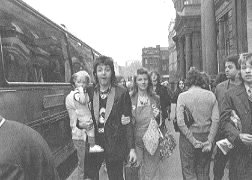But times change and familiarity breeds
affection. Now the Cockburn Association campaigns for the hotel to become a listed
building (if nothing else, it will protect the site from uglier beasts such as the King
James Shopping Centre across the road or the destruction which the university wreaked in
the elegant terraces of George Square in the 1960s). As David Daiches, one of the city's
historians, puts it: the hotel is "so familiar a part of the Edinburgh townscape that
like the Scott Monument of 1840-46 it is accepted almost as a natural feature".
Thanks to George Wieland and the North British
Railway Company the "monster" was put in precisely the right place to dominate
not only the skyline at that end of town, but the social calendar of generations of civic
groups. Robert Louis Stevenson called that corner of North Bridge the windiest spot in
town, "the high altar in this northern temple of winds". But for anyone arriving
by train the NB was the obvious place to stay. For many years anyone entertaining in style
had only three choices: North British, Caledonian and The George. And even when the boom
of new hotels began in the late 1970s there was still nowhere to compete with the sheer
enormity of the banqueting and ball rooms. Indeed, when the hotel's closure for
refurbishment coincided with Edinburgh's turn to host the biennial dinner of the Institute
of Bankers in Scotland, the Edinburgh bankers were forced to hire a room in Glasgow to
feast their guests.

and Pop Stars stayed at the N.B. Paul and Linda McCartney
It was the obvious place for the annual dinner
and dance for all kinds of people, from the Edinburgh Sir Walter Scott Club who in 1985
drank their 77th toast to the memory of Sir Walter with (Lord) Jo Grimmond in the chair
and "Longe de Porc Suedoise" on the menu, to the Master Builders Association of
Edinburgh and District, who the following year chalked up their 105th annual dinner with a
main course of "Roastit ashet O'Bufe wi Wyandour sauce, Ayrshire Tatties an inther
Fruits o' the Soil".
When Beatrice Rankin married Scottish golf
champion Alexander Flockart in September 1949 there was no question about the choice for a
reception with 300 guests. "It was the obvious place to go", she says, "The
rooms were always lovely there. I remember going to the High Constables' and the Dentists'
balls for many years". Besides, her father William Rankin, city fruit and flower
merchant, had business connections in the old fruitmarket nearby. Staff who worked in the
hotel then still remember the display of flowers decorating the dining room and tables for
Beatrice's wedding. In a city just beginning to emerge from the gloom of the Second World
War the wedding must have been a brilliant splash of colour.
A grand hotel inevitably exists in a social
vacuum of its own creation: great events in the outside world may register only as subtle
changes in the day's menu. Bob Cunningham, hotel butcher from 1928 until 1959, remembers
the disgust of the kitchen staff when boiled tripe appeared on the lunch menu in 1946, a
small concession to the post-war austerity reigning beyond the hotel's substantial walls.
But a building as big as the NB could not fail to make a mark on the local economy too. In
1913 for example the hotel paid just under £1,000 rates and taxes which included
contributions to the police rate, poor rate, water rate and "Inhabited House
Duty". Local stores were contracted to supply the formidable inventory of furnishings
and fittings and the newly established workshops of the Royal Blind Asylum had regular
work manufacturing all kinds of basket ware from lines bins to luncheon hampers. Wages
were low - in 1938 Jackie Monteith earned twice as much packing eggs for a farmer as he
did cracking them for the head chef at the NB. But the hotel offered a trade, good
training and plenty of secure employment: while Edinburgh Corporation weekly debated the
problems of unemployment in the early years of this century, the hotel provided work for
300-400 staff at peak times.
 Next
Page Next
Page
|

